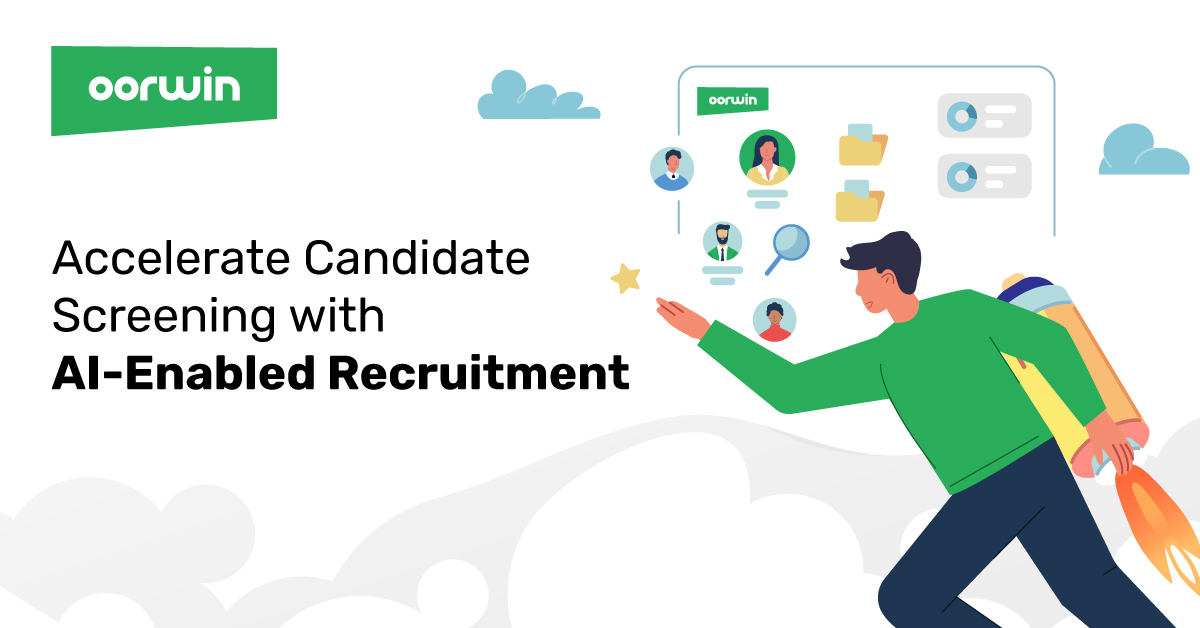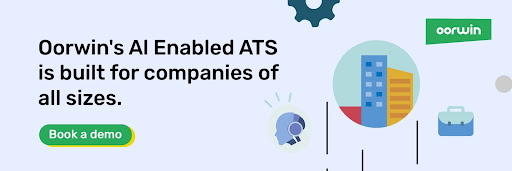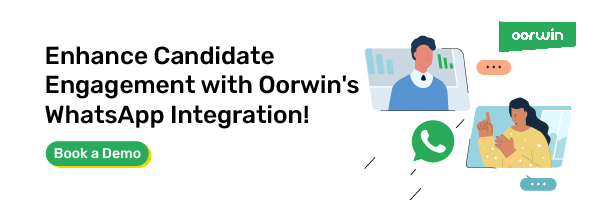Top 8 Methods to Accelerate Candidate Screening with AI
Oorwin
1min read / 6 Sep 2022

Related Articles
AI-Enabled Candidate Screening: Revolutionizing Methods for Screening Candidates
AI-enabled candidate screening is designed to address the single most time-consuming and inefficient aspect of the recruitment process. Despite technological advancements, effective candidate screening remains one of the biggest challenges for recruiters today.
AI-enabled screening in recruitment increases the likelihood that the most qualified candidates will not be overlooked by pinpointing which applicants are most compatible with the job description. According to resources, 35% of talent experts say AI is the leading trend influencing hiring. With recruiters no longer having to scan through resumes one by one manually, they can spend more time focusing on methods for screening candidates and engaging qualified candidates.
What Is Candidate Screening?
Candidate screening in recruitment is the process of reviewing job applications, resumes, and applicant profiles. Through this process, recruiters can identify which candidates have the right qualifications, experience, and skill set to match the job requirements and organization. This important stage occurs after collecting resumes and prior to conducting interviews.
The purpose of this screening is to create a shortlist, ensuring that only the most suitable candidates progress to the next stages of the hiring process.
By effectively screening candidates, recruiters can streamline the hiring workflow, significantly reducing the time and resources spent on unsuitable applicants. This process not only enhances the efficiency of recruitment but also contributes to a more targeted and successful hiring strategy, ultimately leading to the selection of candidates who are qualified and well-aligned with the company’s values and goals.
Why Candidate Screening is Important
An effective screening process is key to quickly identifying top candidates. It goes beyond just assessing skills; it’s also about ensuring diversity and fairness in the hiring process.
Beyond Just Resumes
Screening is more than just a single action; it also encompasses interviews. This approach ensures that hiring decisions are based on more than just resumes, which can sometimes miss the full picture of a candidate’s potential. Interviews allow for a deeper understanding of a candidate’s abilities and personality, making the process more comprehensive and fair.
Modern Screening Methods
Today, candidate screening in recruitment leverages innovative tools like automated systems and AI, which help identify the most suitable candidates for a job more efficiently. These technologies speed up the hiring process and improve accuracy, ensuring the best candidates are chosen. By using these advanced methods for screening candidates, recruiters can focus on the most promising applicants, enhancing the overall quality of the hiring process.
Top 8 Methods Used for Candidate Screening
Whether you are reviewing a small number of applications or sifting through a sea of resumes, the screening process for candidates must adhere to specific methods to streamline the process.
The need to evaluate qualifications, which may include work experience, academic background, abilities, knowledge base, personality, behavior-indicative features, and competencies, are the main thing that is checked (whether by a human eye or artificial intelligence). Listed below are six popular methods used for effective candidate screening.
1. Background Checks
Background checks ensure accuracy and compliance with legal and organizational regulations. Employers should select the most reliable background providers to safeguard applicants’ information. Comparing different background check providers can help identify the best one for the company’s needs. Knowing the correct background check time ensures accuracy and privacy.
2. Assessment
Comprehensive assessments must be completed to make accurate decisions about a job applicant. Assessment tools help to determine whether a candidate has the necessary skills and qualities to perform the job effectively. Advanced technology allows employers to gain more insight into their applicants and quickly decide whether they have met the required criteria. Evaluating job candidates in a shorter time will reduce the time to complete the recruitment process while ensuring they can do the job.
3. Job Interviews
Job interviews are a great way to gauge an applicant’s personality, interest, and understanding of the job. They are a fundamental component of methods for screening candidates, providing deeper insights into their potential. It is also a chance to ask questions and gain an understanding of a candidate’s past experiences and motivations. Knowing how to conduct job interviews properly is essential for the interviewing process and the successful onboarding of new employees. Setting aside the necessary time and resources to plan and prepare for job interviews can help make the process smoother and result in more accurate decisions.
4. Resume Screening/Review
Resumes are the starting point in the screening process, where candidates showcase their skills and qualifications. Enhancing the methods for screening and reviewing resumes allows employers to determine an applicant’s suitability for a position more efficiently. Automation solutions play a significant role here, swiftly shortlisting candidates and enabling managers to concentrate on the most compelling resumes.
In this screening process, paying attention to keywords and phrases that align with the job requirements is vital. This approach helps pinpoint the best candidates, focusing not just on their skills but also their educational background and relevant experience. Additionally, integrating methods for screening candidates, like AI-driven tools, can further refine the process, ensuring a more accurate match between the job requirements and the applicant’s profile.
By streamlining resume screening, recruiters can more effectively identify top talent, making this step a key component in the candidate screening strategy.
5. Reference Checks
Reference checks offer insights into an applicant’s abilities and work history, playing a significant role in the candidate screening strategy. These checks provide insight into a job applicant’s abilities and can help confirm or deny specific skills. They are essential to the recruitment process and should be completed before making an official job offer. Leveraging this process requires asking the right questions and establishing trust while gathering information. Through reference checks, employers can gain an insider view of job applicants, enabling them to make more straightforward decisions.
6. Predictive Analytics
Predictive analytics uses data to predict an applicant’s success, enhancing the screening in recruitment process by providing more accurate assessments. This method offers a more effective way to predict an applicant’s success and determine a company’s best recruitment and prediction strategies. By leveraging predictive analytics technology, employers can use data-based insights to assess performance under certain conditions, leading to more accurate decisions about job applicants. Furthermore, leveraging predictive analytics enables employers to weed out potentially harmful or fraudulent job applications.
7. Video Interviews
An increasingly popular tool in screening candidates, whether live or pre-recorded video interviews, offer a dynamic way to assess candidates, especially in remote hiring scenarios.
Live Videos: These are similar to traditional interviews but conducted on platforms like Skype, Zoom, or Google Hangouts. They’re typically used as an initial screen or later in the hiring process.
Pre-recorded Videos: Here, candidates answer interview questions on video, which recruiters can review later. This format, also known as a one-way video interview, often includes a set time limit and the option for a few re-recordings, depending on the company’s policy. It’s an effective initial screening method.
Video Resumes: Candidates submit a short video introduction showcasing their communication skills, confidence, and body language. This format provides insights into a candidate’s presentation and personality.
Moreover, video interviews are useful for assessing a candidate’s remote work readiness. You can gauge their internet stability, video and audio quality, and their ability to maintain a professional setting for online meetings. This aspect is crucial for screening in recruitment, especially in today’s increasingly remote work environment.
8. Cover letters
Cover letters are an early screening method that offers a glimpse into a candidate’s personality and writing skills. They allow candidates to elaborate on their talents more than a CV does.They also test if candidates follow instructions and reveal their work style. However, they’re only sometimes necessary, especially for roles like coding or design where skills tests are more relevant.
Challenges Recruiters Face During the Candidate Screening Process
The candidate screening process can be challenging for recruiters; the most common 3 challenges are -:
Slow Time To Hire Rate
The ever-growing demand for recruiters to do more with fewer resources and the extensive time needed for candidate screening is detrimental to productivity. And inevitably slows down the time to hire.
Having a longer screening process and time to hire creates a greater risk of losing high-quality candidates to competitors. This is especially true when competitors provide quicker recruitment and hiring experience. An efficient applicant tracking system (ATS) could be helpful in this situation, as it can automate a significant chunk of the procedure and let you review and manage staggering numbers of applications.
Quality of Hire
Hiring the wrong people is expensive. Traditional ATS systems alone cannot measure the success or quality of hires. This leaves recruiters manually collecting and analyzing data to observe recruiting and hiring patterns.
This results in more frequent bad hires being discovered later, creating wasted time and resources for your business.
Volumes of Resumes
Many applications that submit for open roles are considered unqualified or irrelevant. The countless hours spent while recruiters weed these out are better used to tend to qualified candidates, active recruitment, and strategic work.
With such high levels of applicant volume to work through, it is almost inevitable that some good ones will slip through the cracks while recruiters are using their time speaking with less desirable candidates.
Adapting to New Technologies
Keeping up with the latest recruitment technologies and tools can be a challenge. Recruiters need to constantly learn and adapt to new systems that can aid in efficient screening, which requires time and training.
Maintaining Candidate Engagement
In today’s competitive job market, keeping candidates engaged throughout the screening process is crucial. A lengthy or impersonal screening process can lead to a loss of interest from potential hires, especially those with multiple offers.
How To Improve Your Candidate Screening Process With AI-Enabled Recruitment
AI-enabled candidate screening streamlines the recruitment process, reducing hiring time and increasing effectiveness by automating candidate screening. This allows recruiters to prioritize applicants more efficiently without manual screening.
Here are 5 methods by which AI can enhance the candidate screening process:
- Bias Reduction and Diversity: AI-enabled recruitment helps remove human bias and promotes diversity, equality, and inclusion regarding candidate selection. It also helps ensure each applicant has similar experiences to promote fairness.
- Data-Driven Insights: AI-powered talent intelligence platforms provide vast amounts of valuable data insights to recruiters. Features like predictive talent analytics provide data showing which steps in the recruiting and hiring process need to be more efficient and highlight where recruiting funds should be allocated or reduced based on which sources bring in the top candidates.
- Customized Recommendations: AI-enabled talent acquisition solutions provide tailored recommendations by analyzing large data sets, which would be impossible to process manually.
- Enhanced Candidate Engagement: AI tools can personalize communication with candidates, keeping them engaged throughout the screening process. This personalized approach ensures candidates feel valued and informed, improving the overall candidate experience.
- Efficient Resume Parsing: AI can quickly parse through resumes, identifying key skills and qualifications relevant to the job. This speeds up the screening process and ensures a more accurate match between the job requirements and the candidates’ profiles, enhancing the quality of candidate screening.
Advancing Candidate Screening in Recruitment with AI Solutions
When implementing AI-enabled recruitment strategies, recruiters can achieve several advancements:
- Context-Driven Candidate Ranking: Utilize AI-powered pre-screening chatbots to rank candidates based on skills, experience, and location. These tools ensure a precise match with job criteria through context-driven talent selection.
- Streamlined Evaluation and Selection: Automate the process of evaluating and selecting candidates who are most suitable for interviews, enhancing efficiency in the recruitment process.
- Building a Strong Talent Pipeline: Develop a robust talent pipeline to consistently provide your organization with access to top talent, ensuring readiness for future hiring needs.
- Sourcing Passive Candidates: Leverage AI to identify and attract strong passive candidates from various channels, focusing on those whose profiles align closely with the job description.
- Enhanced Hiring Quality: Improve the overall quality of hires by using advanced analytics to track applicant data and recruitment activities, leading to more informed hiring decisions

In today’s highly competitive job market, recruiters need to invest more time and effort in sourcing and engaging the most qualified candidates. AI-enabled recruitment tools offer a significant advantage in this endeavor, streamlining processes and enhancing the effectiveness of talent acquisition strategies.
Transforming Candidate Screening with Oorwin’s AI-Enabled Recruitment
AI-enabled recruitment is revolutionizing the way we approach candidate screening, bringing unmatched precision and efficiency to the process. This innovative method ensures that only the most fitting candidates advance in the hiring journey, aligning perfectly with job requirements and organizational culture.
Oorwin steps into this evolving landscape with its AI-driven solutions, designed to automate and refine the screening process. By leveraging Oorwin’s technology, recruiters can significantly improve the quality of their hires and streamline their recruitment workflows. Oorwin’s tools are adept at handling the complexities of modern recruitment, from parsing large volumes of resumes to enhancing candidate engagement through personalized interactions. This leads to a more efficient hiring process, saving time and resources while ensuring the best talent is brought on board.
Embrace the future of recruitment with Oorwin’s AI solutions, and transform your talent acquisition strategy. Discover more about how Oorwin can elevate your recruitment process.
Frequently Asked Questions
How does AI enhance the candidate screening process?
AI streamlines candidate screening by automating the evaluation of resumes and applications, quickly identifying the most suitable candidates based on skills, experience, and other relevant criteria.
What do pre-employment background checks look for?
Pre-employment background checks typically look for information such as a potential employee’s criminal history, credit history, education, references, and prior employment.
Are there any restrictions on pre-employment screening?
Many states have laws that regulate what employers can and cannot do during pre-employment screening. In general, employers cannot access certain types of information, such as Social Security numbers or financial records. Additionally, employers must obtain the candidate’s consent to conduct employment screening.
What is involved in an automated screening process?
Automated screening processes can include:
- Checking references.
- Validating education.
- Verifying criminal records and credit histories.
- Using bots to search for keywords in resumes.
Automated screening can also send automated emails to a candidate’s previous employers for verification. Automated screening processes are often more efficient than manual methods, saving a business time and money.
How does Oorwin utilize AI in candidate screening?
Oorwin leverages AI to automate and refine the screening process, offering advanced analytics for insightful hiring decisions and tools for effective candidate engagement, thus accelerating the recruitment process.
Popular Articles..
Blog

1min read / 25-Jun-2025
Master Effective Interview Techniques with Oorwin: A Step-by-Step Recruiter’s Guide
Blog
Blog
Get the latest Oorwin releases, updates, success stories & industry news
 Back
Back


